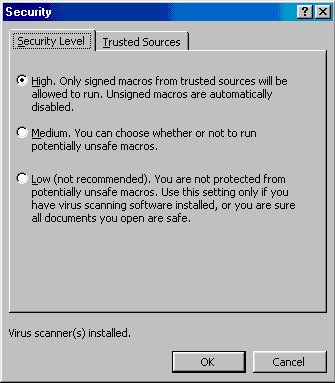Written by Allen Wyatt (last updated February 24, 2024)
This tip applies to Word 2000, 2002, and 2003
If you recently upgraded from Word 97 to a later version of the program, you may have run into a situation where the macros you created in Word 97 no longer run because they are disabled. This can be disturbing, particularly if you absolutely need the macros to get your work done.
The reason this happens is that the later versions of Word (beginning with Word 2000) include a macro security feature which wasn't present in Word 97. The default security setting, when first installing Word, is "high." This setting automatically disables any macros in any document that's not in the defined template folder or digitally signed by a 'trusted source' (for more info read Word Macro Security in online help).
This automatically presents several possible solutions. First of all, if the disabled macros are part of a template, you can move the template to the defined templates folder. The typical default template folder is C:\Program Files\Microsoft Office\Templates, but if it's been changed to somewhere else, you can remind yourself of where by looking at the folder setting for User Templates on the File Locations tab of the Options dialog.
The second possible solution is to get your macros "digitally signed." Such a process is beyond the scope of this tip, but you can find help on the process in the online help files or at the Microsoft Web site.
Finally, you can lower the default setting for the macro security used by Word. For instance, you can set it to "Medium," which results in only a warning message about the macros rather than an outright disabling. To change the security setting, follow these steps:

Figure 1. The Security dialog box
Note:
WordTips is your source for cost-effective Microsoft Word training. (Microsoft Word is the most popular word processing software in the world.) This tip (806) applies to Microsoft Word 2000, 2002, and 2003.

Create Custom Apps with VBA! Discover how to extend the capabilities of Office 2013 (Word, Excel, PowerPoint, Outlook, and Access) with VBA programming, using it for writing macros, automating Office applications, and creating custom applications. Check out Mastering VBA for Office 2013 today!
Part of documenting macros is to provide a good, succinct description of what they do. Changing the description of an ...
Discover MoreWord uses keyboard shortcuts for all sorts of tasks. Sometimes you may create a shortcut that messes up one of the other ...
Discover MoreMacros are part of the document and template that are loaded into memory when you open a file. If you have "junk" macros ...
Discover MoreFREE SERVICE: Get tips like this every week in WordTips, a free productivity newsletter. Enter your address and click "Subscribe."
There are currently no comments for this tip. (Be the first to leave your comment—just use the simple form above!)
Got a version of Word that uses the menu interface (Word 97, Word 2000, Word 2002, or Word 2003)? This site is for you! If you use a later version of Word, visit our WordTips site focusing on the ribbon interface.
Visit the WordTips channel on YouTube
FREE SERVICE: Get tips like this every week in WordTips, a free productivity newsletter. Enter your address and click "Subscribe."
Copyright © 2024 Sharon Parq Associates, Inc.
Comments